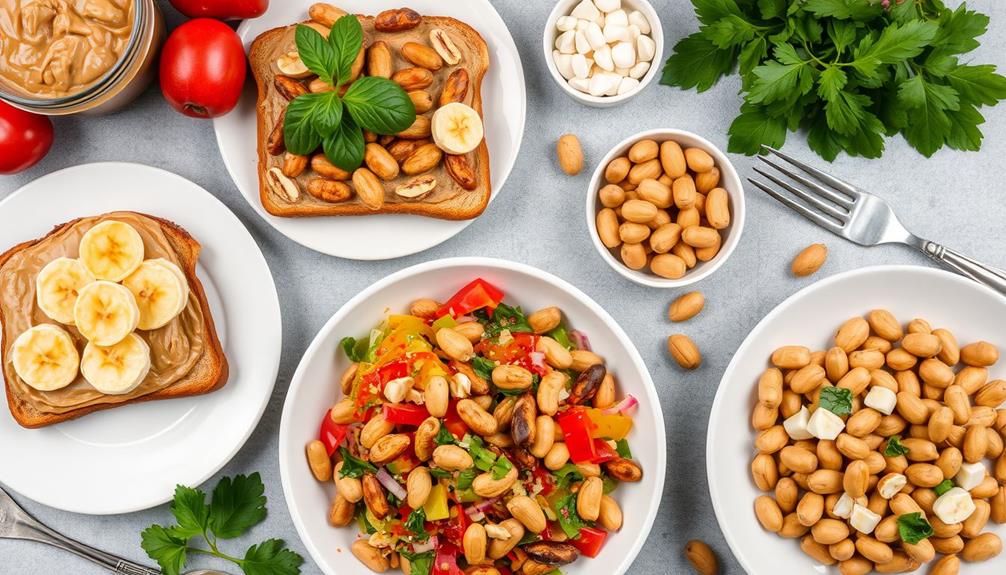Groundnuts are a fantastic choice for those unusual pregnancy cravings. They're packed with protein, healthy fats, and essential vitamins that benefit both you and your baby. You can enjoy them roasted, mixed into smoothies, or in creative recipes like groundnut chikki or peanut butter cookies. Try groundnuts paired with fresh fruits for a sweet treat or tossed in spice for a savory snack. Incorporating these versatile nuts into your meals can satisfy your urges while ensuring you're getting crucial nutrients. Keep exploring to uncover even more delicious and nutritious groundnut recipes tailored for your pregnancy cravings!
Key Takeaways
- Groundnut chikki, made with roasted groundnuts and jaggery, offers a sweet and nutritious treat to satisfy pregnancy cravings.
- Peanut butter cookies and energy balls provide a quick, satisfying dessert rich in protein and healthy fats.
- Groundnut smoothies blended with bananas and honey deliver hydration and energy while curbing sweet cravings.
- Spicy roasted peanuts serve as a crunchy snack option, combining savory flavors with energy-boosting nutrients.
- Groundnuts mixed with honey and dark chocolate create a delightful sweet treat that satisfies cravings with essential nutrients.
Benefits of Groundnuts in Pregnancy
Groundnuts, often referred to as peanuts, offer numerous benefits during pregnancy that can greatly support both you and your developing baby. One of the primary advantages is their high protein content, providing essential amino acids important for fetal growth and development.
These little legumes are also packed with healthy fats, particularly monounsaturated fats, which promote heart health for both you and your baby. Additionally, incorporating a balanced diet rich in whole foods, including groundnuts, can enhance your overall health during pregnancy holistic lifestyle approach.
Another essential nutrient found in groundnuts is folate. This B-vitamin plays an important role in preventing neural tube defects in your developing fetus, making it an important addition to your diet.
Additionally, groundnuts are rich in magnesium, which can help alleviate those pesky leg cramps that often accompany pregnancy and support overall muscle function.
Beyond these nutrients, groundnuts also contain antioxidants like vitamin E, which combats oxidative stress and bolsters your immune system during this significant time.
Sweet Groundnut Recipe Ideas
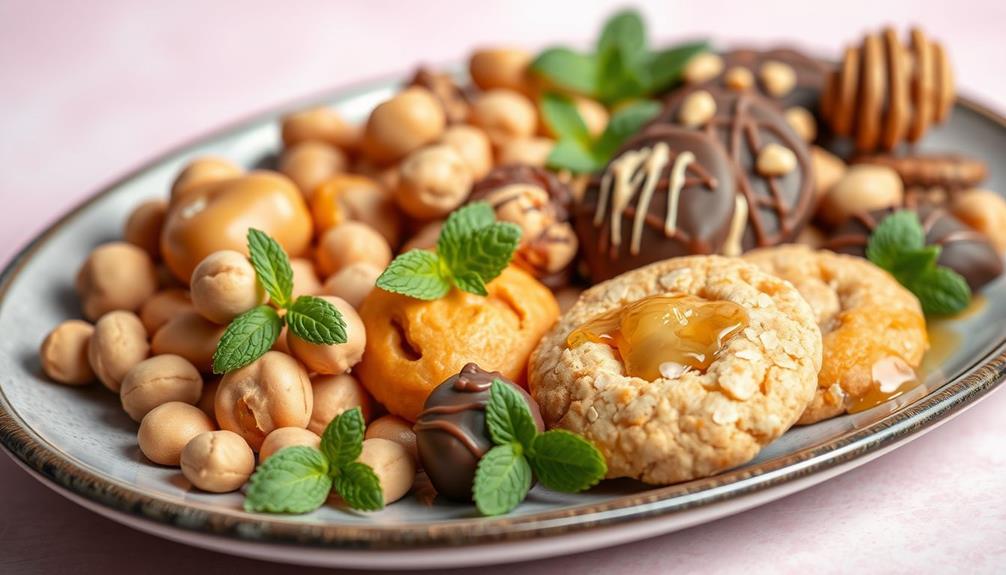
Sweet Groundnut Recipe Ideas
If you're looking to satisfy your sweet tooth during pregnancy, groundnuts are a fantastic ingredient to incorporate into your recipes. These little legumes are packed with protein and healthy fats, making them perfect for curbing those sweet cravings.
Additionally, incorporating essential oils for relaxation can enhance your overall well-being during this special time. One delicious option is groundnut chikki, a traditional Indian candy that combines roasted groundnuts with jaggery, delivering a tasty and nutritious treat.
You can also whip up some peanut butter cookies or energy balls using peanut butter, oats, honey, and chocolate chips for a quick dessert that's both satisfying and fulfilling.
If you want something invigorating, try blending groundnuts into a smoothie with bananas and a drizzle of honey. This creamy drink not only tastes great but also provides an energy boost and aids digestion.
For a simple yet delightful snack, drizzle groundnut butter over fresh fruits like apples or bananas. This combination offers a wonderful mix of sweet and savory flavors while delivering essential nutrients for a healthy pregnancy.
With these sweet groundnut recipes, you'll find it easy to satisfy your cravings while nourishing both you and your baby.
Savory Groundnut Dishes
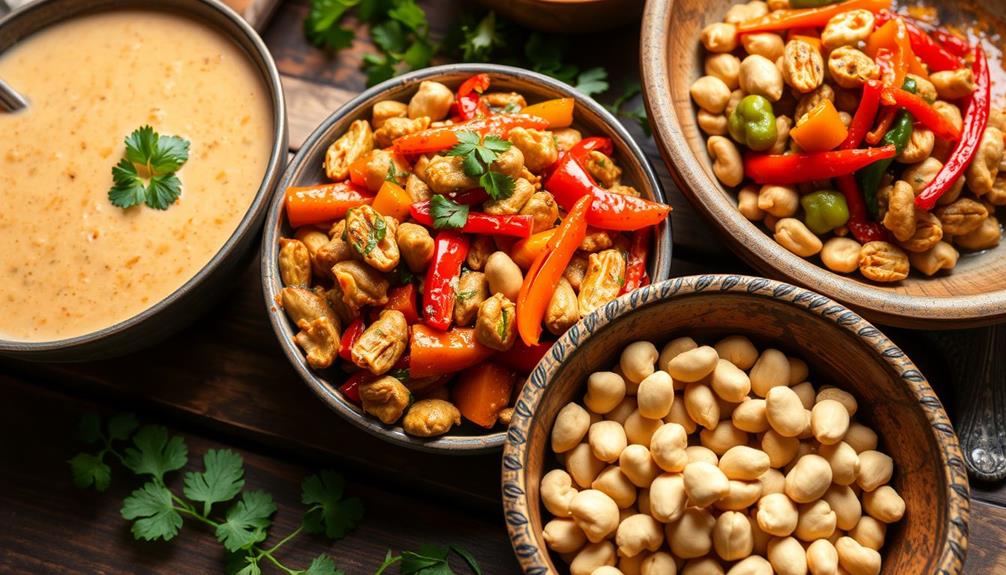
When you're looking for savory dishes during pregnancy, groundnuts are a fantastic choice thanks to their rich protein and healthy fat content.
Incorporating raw food principles into your meals can enhance their nutritional value and flavor. You can easily whip up snacks like roasted groundnuts or incorporate them into flavorful stir-fries and stews that not only satisfy your cravings but also boost your nutritional intake.
Let's explore some delicious ways to enjoy groundnuts while supporting your health and your baby's development, including the benefits of raw food diets for pregnancy.
Nutritional Benefits of Groundnuts
Packed with essential nutrients, groundnuts offer numerous benefits for pregnant women. They're not just a tasty snack; they're also packed with the nutrients you need to support your pregnancy. Groundnuts are rich in protein, providing essential amino acids necessary for fetal growth and development. Their high folate content is important in preventing neural tube defects, making them a smart choice during your pregnancy.
Here are some key nutritional benefits of groundnuts:
- Healthy Fats: Groundnuts are an excellent source of monounsaturated fats, essential for cardiovascular health.
- Protein: They provide the protein needed for both you and your growing baby.
- Folate: A key nutrient that supports fetal development and helps prevent birth defects.
- Minerals: Groundnuts contain magnesium and phosphorus, which are important for bone health and energy metabolism.
- Antioxidants: They offer antioxidants like resveratrol and vitamin E, which help combat oxidative stress and boost your immune system.
Incorporating groundnuts into your diet can help meet your nutritional needs and satisfy those weird cravings during pregnancy!
Easy Groundnut Snack Ideas
Savory groundnut dishes are a fantastic way to enjoy the nutritional benefits of groundnuts while satisfying your cravings during pregnancy. If you're in the mood for spicy food, try making spicy roasted peanuts. Just toss raw groundnuts with your favorite spices, roast them, and enjoy a crunchy snack that's packed with protein and healthy fats.
Another nutritious option is groundnut soup. Combine groundnuts with fresh vegetables and spices for a creamy, comforting dish that's perfect for any time of day.
If you love peanut butter, consider using it in savory recipes. A peanut sauce for stir-fried vegetables or noodles can elevate your meals while adding flavor and nutrition.
Don't forget about salads! Toss groundnuts into your favorite greens for an extra protein boost and a satisfying crunch.
You can also create a trail mix with groundnuts, dried fruits, and seeds for a quick, on-the-go snack. These easy groundnut snack ideas not only cater to your cravings during pregnancy but also guarantee you're nourishing both yourself and your baby. Enjoy these delicious ways to incorporate groundnuts into your diet!
Groundnuts in Unique Combinations
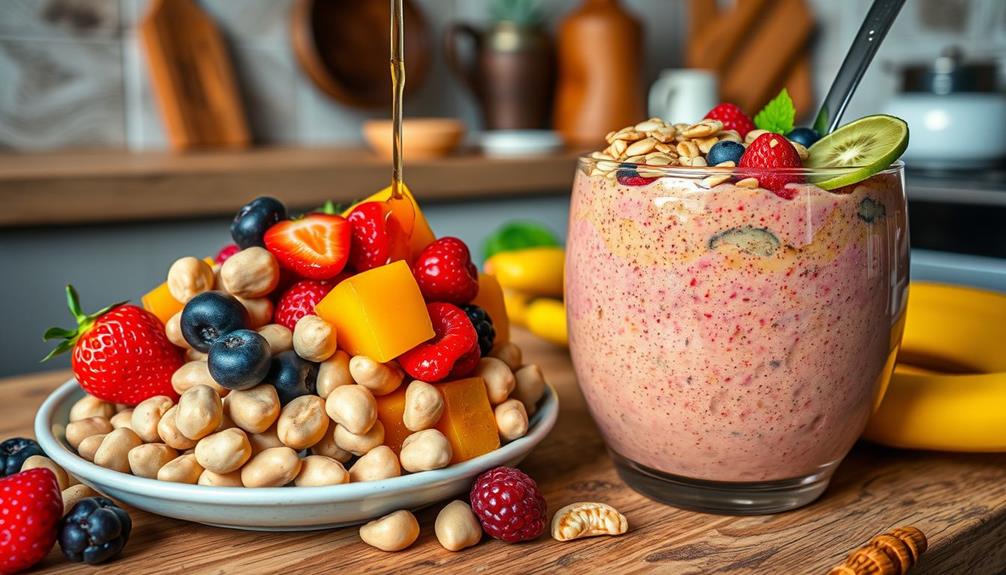
Groundnuts aren't just for savory dishes; they shine in unique combinations that satisfy your cravings.
For instance, pairing groundnuts with fruits not only enhances flavor but also boosts your nutrient intake, making them an excellent choice during pregnancy.
You can enjoy crunchy and creamy pairings, like peanut butter with pickles, or indulge in sweet and savory mixes, such as chocolate-covered peanuts.
These combinations not only taste great but also provide essential nutrients during your pregnancy, especially when you consider the specialty beans for espresso that can enhance your overall diet.
Crunchy and Creamy Pairings
If you're looking for delicious ways to satisfy those pregnancy cravings, consider the delightful combinations of groundnuts with creamy and crunchy ingredients. Groundnuts, packed with protein and healthy fats, can be the star of your snack game. When paired with creamy ingredients like yogurt or ice cream, they create a satisfying treat that hits both textures just right.
Here are some unique pairings to try:
- Groundnuts blended into peanut butter for spreading on whole-grain toast.
- Crunchy vegetables like carrot sticks dipped in a spicy peanut sauce.
- A yogurt parfait layered with groundnuts and fresh fruit for a protein-rich snack.
- Groundnuts mixed with honey and dark chocolate for a sweet, crunchy treat.
- Stir-fried vegetables tossed with groundnuts for added crunch and nutrition.
These combinations not only curb your cravings but also elevate your meals with a delightful crunch and creaminess.
Satisfy your desire for bold flavors while ensuring you're getting essential nutrients for both you and your baby. Enjoy the balance of flavors, and let your taste buds rejoice!
Sweet and Savory Mixes
Combining sweet and savory flavors can elevate your snack game during pregnancy, and groundnuts fit perfectly into this mix. For instance, try pairing groundnuts with dark chocolate. This sweet and savory treat not only satisfies those weird pregnancy cravings but also delivers protein and healthy fats essential for you and your baby.
If you're in the mood for something salty, mix groundnuts with honey and a sprinkle of sea salt. This combination creates a delicious snack that boosts your energy levels while taming cravings.
For a spicy kick, toss groundnuts in sriracha sauce, offering a unique blend of heat and flavor alongside that satisfying crunch.
Don't forget about smoothies! Blend groundnuts with bananas and yogurt for a creamy drink that balances sweetness with nutty goodness, perfect for hydration.
Nutritional Value of Groundnuts
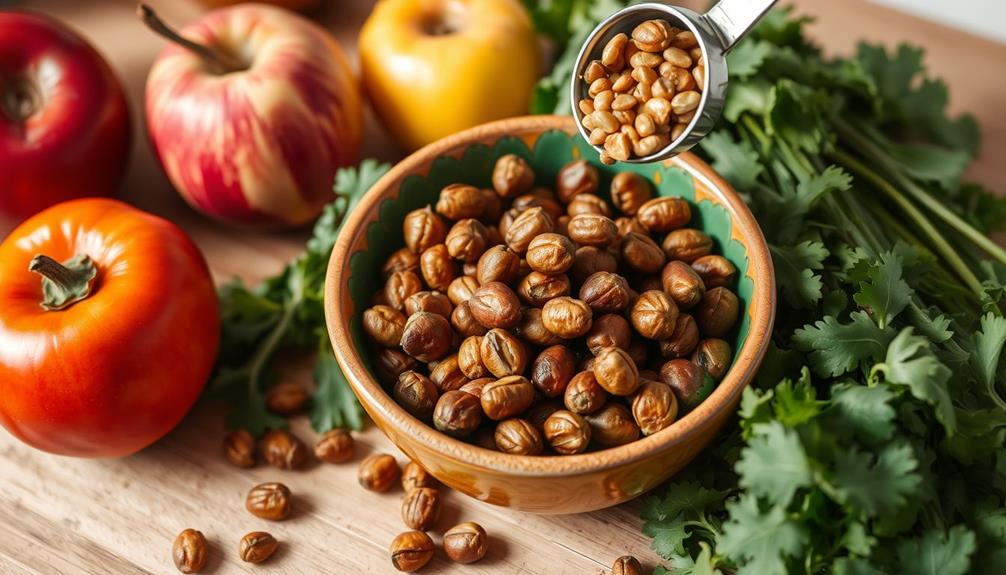
Packed with essential nutrients, groundnuts offer a wealth of benefits for pregnant women. Their impressive nutritional value makes them a great addition to your diet during this special time.
You'll find that groundnuts are particularly beneficial due to their high protein content and healthy fats, which support both your health and your baby's development. Additionally, including diversification of retirement portfolio in your overall health strategy can guarantee a balanced approach to wellness beyond just diet.
Here are some key nutritional highlights of groundnuts:
- Protein: About 25 grams of protein per 100 grams, vital for fetal growth.
- Healthy Fats: Rich in monounsaturated and polyunsaturated fats, promoting heart health.
- Essential Vitamins: Packed with vitamin E, magnesium, and folate, supporting overall maternal health.
- High Fiber: Contains approximately 8.5 grams of fiber per 100 grams, aiding digestion and relieving constipation.
- Antioxidants: Includes compounds like resveratrol, which may help reduce inflammation and improve circulation.
Incorporating groundnuts into your meals can help you meet your nutritional needs, guaranteeing both you and your baby stay healthy throughout your pregnancy journey.
Tips for Preparing Groundnut Recipes
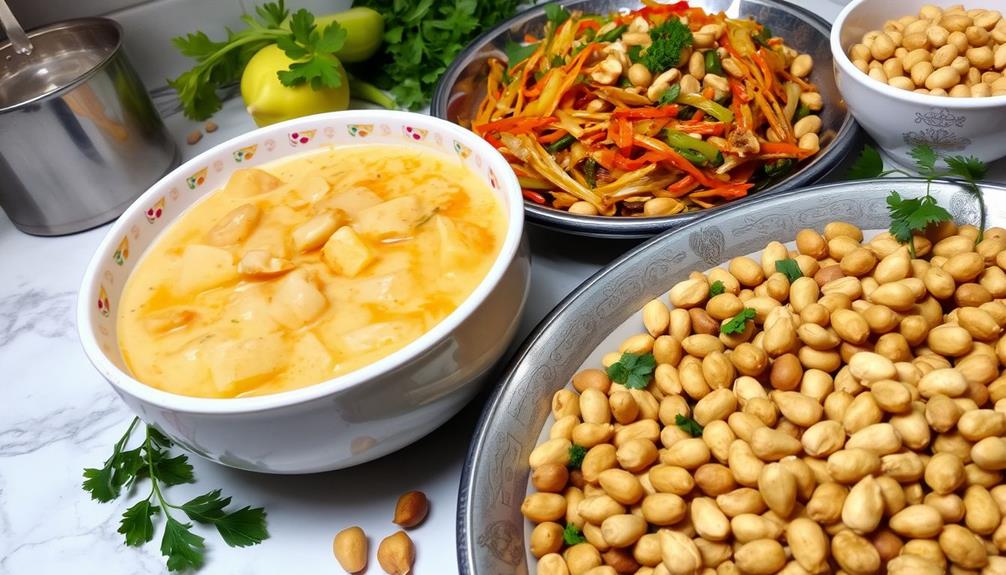
Preparing groundnut recipes can be a delightful culinary adventure during your pregnancy. Groundnuts, also known as peanuts, are packed with protein, healthy fats, and essential nutrients, making them a nutritious addition to your meals.
To enhance their flavor, consider roasting groundnuts; this not only boosts their crunchiness but also satisfies those cravings for a crunchy texture. You might also find it helpful to explore best affordable baby books that can provide you with comforting reads during this time.
You can also blend groundnuts into smoothies or create your own nut butter, which adds a creamy, protein-rich element to various dishes while satisfying sweet cravings.
If you're in the mood for baking, try incorporating groundnut flour into pancakes or muffins. This will increase their nutritional value and provide a unique flavor twist.
For a balanced snack, pair groundnuts with fruits like bananas or apples. You can also experiment by adding them to savory dishes with spices, catering to both your sweet and salty cravings.
Just remember to enjoy groundnuts in moderation, as they're high in calories. By following these tips, you can create delicious and nutritious groundnut recipes that will support both you and your growing baby during this special time.
Satisfying Cravings With Groundnut Snacks
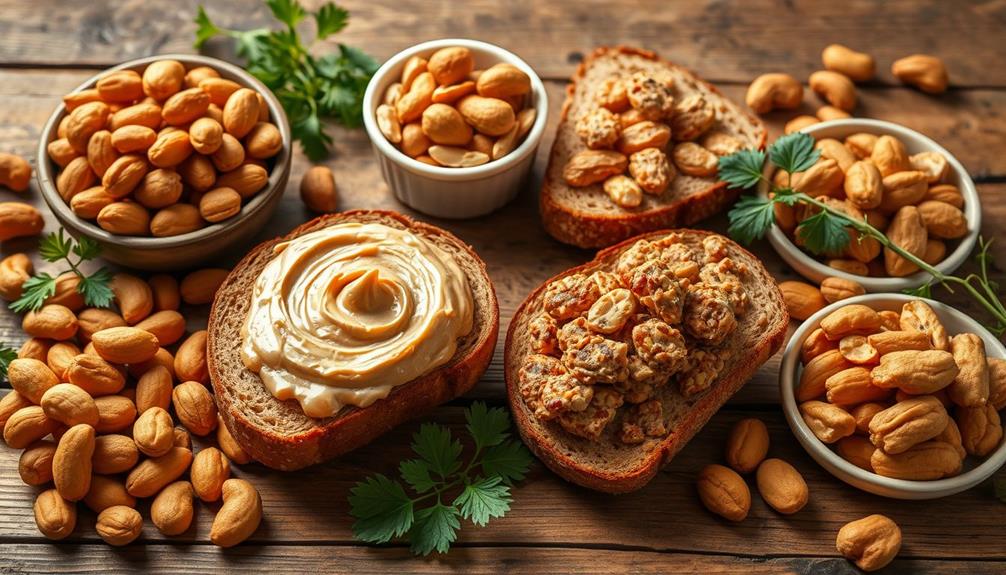
When you're looking to satisfy those pregnancy cravings, groundnut snacks can be a delicious and nutritious choice. Groundnuts, or peanuts, are packed with protein, healthy fats, and essential nutrients like folate and magnesium, making them a perfect snack option during this special time.
Additionally, ensuring a balanced diet is important for overall health, as highlighted in dog health tips. Here are some tasty ideas to curb your cravings:
- Peanut butter on whole-grain toast: A quick and satisfying breakfast or snack.
- Roasted spicy peanuts: A crunchy treat that brings flavor and energy.
- Peanut butter and banana bites: A sweet combo that's nutritious and fulfilling.
- Groundnut yogurt parfait: Layer yogurt with groundnuts and dried fruits for a delightful treat.
- Peanut soup: A comforting dish that satisfies savory cravings while providing nourishment.
Incorporating these groundnut snacks into your diet not only satisfies your cravings but also boosts your nutrient intake, keeping you energized and healthy throughout your pregnancy.
Whether you enjoy them raw, roasted, or as peanut butter, these snacks are sure to satisfy your taste buds while providing the essential nutrients you and your baby need.
Frequently Asked Questions
What Are the Weirdest Craving Combos During Pregnancy?
When you're pregnant, your cravings can get pretty wild.
You might find yourself wanting pickles dipped in ice cream or chocolate-covered bacon. Some women even crave combinations like pasta with ketchup or apples slathered in mayo.
It's all about those unique flavor pairings that seem bizarre to others but make perfect sense to you in the moment.
Embrace the experience, and don't be afraid to indulge in those unusual cravings!
How to Satisfy Pregnancy Cravings?
To satisfy your pregnancy cravings, try incorporating a mix of flavors and textures.
You can whip up healthy snacks like yogurt with fruits or nuts for a sweet and crunchy treat.
Consider creating savory dishes that combine your favorite ingredients, or indulge in a comforting soup.
Experimenting with different combinations will help you find what hits the spot, whether it's spicy, sweet, or a bit unusual.
Keep it balanced, and enjoy the journey!
What Food Do Pregnant Ladies Crave the Most?
Pregnant women often crave a variety of foods, with salty pickles and sweet treats like ice cream topping the list.
You might find yourself reaching for chocolate and savory snacks, reflecting both comfort and nutritional needs.
Many crave unusual combinations, like pickles with peanut butter or hot sauce on fruit.
These cravings can change daily, so embrace them as a natural part of your pregnancy journey, satisfying both your taste buds and your body's needs.
What Foods Satisfy Pica Cravings?
If you're dealing with pica cravings, it's imperative to focus on nutrient-rich foods. Incorporate lean meats, legumes, and fortified cereals into your diet to help address potential iron deficiencies.
Calcium-rich foods like dairy products and leafy greens can also be beneficial. Consulting a healthcare provider is vital for personalized advice.
Conclusion
Incorporating groundnuts into your pregnancy diet is like adding a splash of color to a canvas—vibrant, satisfying, and essential. With their rich nutritional benefits, these versatile nuts can help curb those unusual cravings while delighting your taste buds. Whether you opt for sweet treats or savory dishes, groundnuts offer a delicious way to nurture your body and your baby. So, get creative in the kitchen and let these tasty recipes support you through this beautiful journey!

